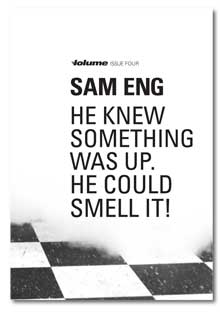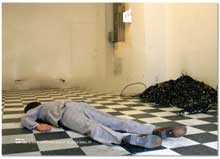 |
|||||||||
|
|
| ...Publications: Volume | ...Sam Eng | ||||||||||||||||
|
Sam Eng SPECULATIONS AND CONTINGENCIES We live in an era of ever-increasing anxiety, whether we are able confirm the source of our own particular states of unease, or not. Understandably it is much more troubling not to be able to identify what it is that’s ‘not quite right’ and it’s in that space, between identifying that ‘something’s up’ and knowing the cause or reason behind the slippage from ‘all right’ to ‘not quite’, that Sam Eng positions his installation for the Volume series within The Physics Room’s Gallery C. Whether motivated by an earnest interest in the historic specificities and previous uses of the site or primarily by the dystopian fascination present in much of Eng’s recent work, here the artist holds up a reconstructed ‘history’ of the space in testament to the murky realities and grey areas that exist beneath the glossy surfaces and narratives of everyday life. Like some kind of Time Lord, Eng has transported the gallery back to a moment years earlier, 1981 to be precise, when Gallery C was part of the regional administrative hub of The Post Office Savings Bank. The space finds itself transformed into a simulacrum of its former self through various temporal distortions; the polished wood of the gallery floor reverts to the chequered linoleum of another era, sooty venetian blinds shield the window and flickering neon tubes bathe a life-sized version of the artist lying face down on the floor in bright but macabre light. A variety of hums, gurgles and rumbling sonic disruptions ricochet around the room having emanated from either of the two ominously charred blobs expanding across the floor and enveloping an array of loose wiring spread along the length of the space, or the figure itself. Also, periodically the Gas Flood extinguisher system issues thick clouds from its wall-mounted vents, which swallow up the space making the whole scene even more indistinct. Eerily abandoned, like some kind of evidential exhibit, there is a sense of nervous uncertainty that Eng solicits, panders to and ultimately preys upon within the context of this work. Upon entering the space viewers find themselves confronted with a large sign lit boldly with the imperative “GET OUT NOW” emblazoned in fire engine red upon its surface. Whether you choose to read the apparition of this sign as some kind of regurgitated testament to the ‘safety conscious’ but frequently unsound mechanisms of the incorporated state or as a more sinister directive to mind your own business; either way Eng deliberately plays our curiosity off against any self-preserving response of indifference that such a scene would inevitably induce. Such a nightmarish flashback reeks of the growth-driven logic of the corporation rather than harking merrily (or desperately) back to the tangibly benevolent, but long-lost heyday of public institutions like The Post Office Savings Bank. The dystopian orientation of Eng’s work points to something sincerely troubling through his representation of the repressed, or at the very least occluded, cultural history of the space. Yet Eng mischievously holds back from putting a finger directly on the cause of the dread-filled uncertainty that permeates the installation. What is it that we’ve walked into, or in on? What actually happened here and how come no one knew about it? The thing is, someone somewhere did know, but whether it’s those malevolent looking blobs of foam, dissipating particles of gas or pervasive rhetorical associations that serve to unsettle our expectations—Gallery C is full to the brim and potentially overflowing with something dreadful. He knew something was up, and he’d have been a fool not to. PLAN FOR THE WORST Mining a wide array of personal and collectively sensed fears, Eng’s installation ironically seems to beg us not to be caught-up in the spectacular narratives so often enlisted in the service of catastrophic events. Much like some kind of drill, Eng can be seen to position his version of the space’s worst-case scenario as if to allay our fears by desensitising us to the most ‘unthinkable’ of scenes. In a strange coincidence during this show’s installation a bomb threat was located only a couple of blocks away from the gallery. It turned out the ‘device’ found outside the local offices of the IRD was a fake, just a couple of tubes connected by a few wires that someone had mocked-up for a ‘bad taste’ party. The perpetrator had decided to ditch it in a rubbish bin after he’d been turned away from some of the bars in the area, but ended up phoning the cops the next day to let them know exactly what the bomb squad was attempting to detonate after a few hours of the city being on high alert. The ridiculous nature of such a spectacle occurring here, in Christchurch, the painfully earnest response of ‘the authorities’, and the practical, homegrown explanation for such an incident would seem more than a little comical to most. What interests me about this particular ‘non-event’ is the transference from the socially endorsed behaviour of doing one’s civic duty and being a ‘Tidy Kiwi’, only to find yourself potentially facing charges for crossing the line between acceptable behaviour and practices that serve to threaten the received order. Eng’s work has often asked its audience to consider the times at which such trouble-making, if not sincerely troubling forms of malevolence, emerge to claim a position within the open and political field of public life. Yet, just as this spectacular event found itself recounted on the newsprint pages of the following day, Eng’s work could also be described as “an art that cultivates the dodge” where what is given to be seen is one thing, but what we believe and the story we recount is just as important as the original event, if not actually more so. NARRATIVE SPACES/NARRATING SPACE “Stories about places are makeshift things. According to Michel de Certeau, places that embody and make concrete a form of shared social consciousness, such as the public space of The Physics Room, can be seen to have magical potential as they serve as portals for the imaginative and actual possession of spaces within the city. Furnished by leftovers, slips and semantic spills, the myths, fables or urban legends “that haunt urban space like superfluous or additional inhabitants” serve to make the city habitable for those that continue to live there and sustain such tales. Consequently, those familiar spaces that accommodate the shadows of distant or illegible histories lost from common knowledge retain the potential to serve as anomalous points or tears within the city’s fabric of received narratives. Such locations preserve the potential to be occupied imaginatively and put to use in myriad ways that differ from their present function or intended role. De Certeau notes, “heterogeneous and even contrary elements fill the homogeneous form of the story. Things extra and other (details and excesses coming from elsewhere) insert themselves into the accepted framework, the imposed order” or what was previously accepted as the norm. Eng’s gesture can therefore be seen to test our awareness of the space, forcing the boundaries of any passive acceptance of Gallery C’s current role or status, while demanding we consider the potential value of those times at which the monstrous, insidious or unruly presence of things seemingly superfluous to our expectations in fact play an infinitely enabling role through their contamination of the ‘official line’ or the accepted rhetoric of ‘order’. Whether in the service of Eng’s dubious authenticity or the haunting potentiality of this installation, the fabric of narratives that continue to clothe the physical spaces of the city and continue to make room for us to encounter our most troubling fears might yet prove to be the most ambitious step towards a future less unanticipated and monstrous than elements of our own past. Kate Montgomery
Sam Eng is a Christchurch based artist and art educator. His practice has investigated sonic disruptions, actions and performance in public spaces. Eng has been involved in many artist-run projects, and was co-chair of the Board of Trustees for High Street Project for a number of years. He has also been involved with a number of touring exhibitions of work by experimental and emergent artists from Christchurch, and is currently completing his MFA at the University of Canterbury. Kate Montgomery currently co-chairs the HSP Board, writes a bit here and there and is looking forward to taking a container full of HSP's best and brightest to Melbourne's Next WaveArts Festival in March 2006.
Photo credit: Sam Eng. Design: Aaron Beehre “Tea and apathy as ‘bomb’ paralyses city centre”, Kim Knight & Janine Bennets, Sunday Star Times, 9 October 2005, A3. Related Sam Eng: 28 September - 22 October 2005
|
||||||||||||||||

